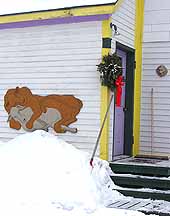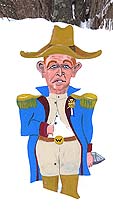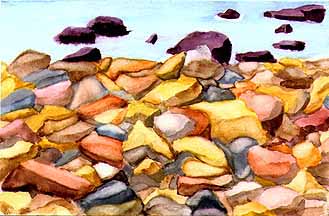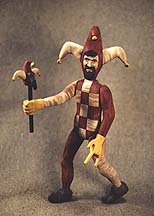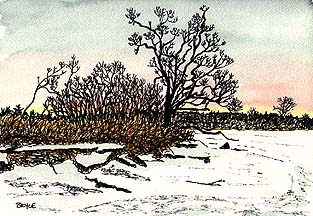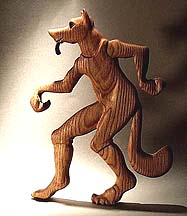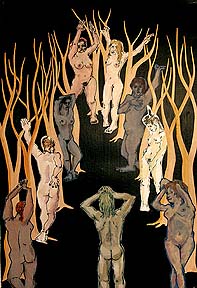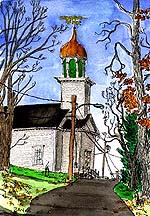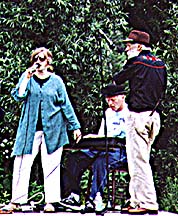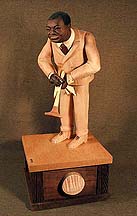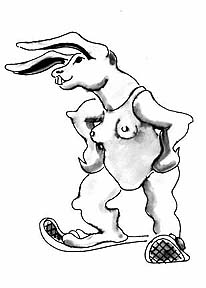| It’s been snowing on and off for two weeks now, and every scene is a post card. The snow is banked high around the house, and I’ve been holed up, rummaging through my back issues, trying to figure out what it’s about. I’m discovering my piles are pretty deep, too. Can you dig it?
When I first began posting to the brycemuir.com web site, I imagined it would be a virtual gallery. A place where I could see and show the images of my work –– and get a sense of the pattern. But my postings evolved out of our road journals, and the site became a vehicle for e-journalizing about the life of a local artist and a small town. What artwork I posted was by way of illustration. The site became a picture-book chronicle not a showcase |
| If each life is a tale we tell in the living, a local chronicle is one way to find out our stories. But a spun yarn is more like Ariadne’s thread than a view of the whole tapestry. So I set about marshalling my images, and re-designing brycemuir.com, in hopes of finding a wider perspective. I’d run out of rap, anyhow.
The first stunner is the shear volume of images I’ve troved up. And how few of them work by themselves. You can’t expect photos of 3-dimensional work to tell the whole tale, especially when so much of it’s about touch. But you’d think more of the pictures would be evocative images which stand alone. Sad to say, the percentage of durable images from the 2-dimensional work isn’t much higher, for all the volume. Still, there’s enough to keep me up nights sorting and sifting. |
|
Then there’s the diversity of media. I knew I was shuffling a full deck, but I hadn’t realized there were so many jokers. What’s that about? Fickle-mindedness? A.D.D.? Isn’t it a bit greedy to try to learn how to paint watercolors and play the piano when your plate is already full? You’d think mastering one media and turning it into a livelihood would be ambition enough. Instead I’m spread all over the landscape. So, after churning the the whole megillah, what rises to the surface? |
| A clearly developed sense of whimsy, for starters. If this stuff reflects the age, it must be the Age of Absurdity. I can’t be serious to save myself –– at least not for long.
A persistent need to improvise. Just as I can’t play the same lick on the flute twice running, I find any one genre confining. This is two-edged: I can delight in the freshness of childsplay with a new medium, but I’m too impatient for mastery. It has to be play, never work. A study in self-indulgence, or the apotheosis of Homo ludens? Can you become a master amateur? |
| A need to connect the outer and the inner. Whatever attempts I make at abstraction in visual forms, I can’t escape the representational. But my renderings of “reality” are suffused with symbolism. The inner images always attempt to rise up through the work. I keep trying on new ways to portray the world, but the only portrayals that work tell symbolic tales. The only landscapes I like take me out of the simple immediacy of place. |
| An emphasis on Transformations and the Trickster. Animal portraits, liminal figures, shape shifters, fairytale characters –– the stuff of Trickster stories. My strongest work symbolizes the transformative, or moves along the borders between categories. Are they landscapes or a cartoons? Moose or Men? Two-dimensional or three? Lawn decorations or political statements? Portraits or playthings? Images to fondle or magical implements? Absurd or ridiculous? The work seems to be caught in mid transformation. |
| The work features form over color. The landscapes are line drawings with a colored wash. The carvings are in muted natural wood tones. The barnboards fade to gray. The work may be colorful in content, but it is about form foremost. I see line and form before I sense color. What does that tell you?
Similarly, I celebrate the tactile and the tangible. This whole game began with playthings to be handled. I still manipulate each piece of sculptural composition, hold the work to the tool more often than not. Over time the woodwork has become increasingly visual –– you stand back and look rather than reach out to touch –– but the elements are still rounded, touched by a tangible sensibility. Even the landscapes have a distinct thingyness. They aren’t studies of light and shadow and color – they are renderings of trees and clouds and rocks and junk in the field. It’s about stuff, apparently. |
| All this visualizing is a far cry from what you’d expect of the 18-year-old would-be journalist on the Journal-American. Yet the works still reach for reportage and commentary. A chronicle of the seasons of a small town, and a snapshot of what it looked like at the millennium. Scenes from the American ethos, and figures out of the local seasons. Smart-ass asnides about town politics. Public statements with signboards. Even the inner symbolism is made tangible for outer expression. Still telling tales out of school. An incurable malady. |
| And now I see the words, too, are objects to be crafted and assembled, played with and made to music across the page. Even writing is a tangible business of composing soundscapes out of visual details. The sense may inspire, but the sound is what satisfies.
And what about my newest medium: playing an instrument? Of all the whims this one seems most abstract, and demands the most developed technique. Isn’t it concerned with feeling and the sense of time? Isn’t it the ultimate in intangibility? Perhaps. But my taste is to the physical tunes: Blues and Rock. It has to dance. I’m a very physical player. I beat up my flutes, and pound the keyboard. |
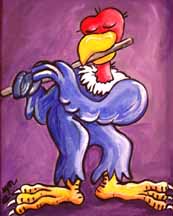 Blues Buzzard (Painting by Liz McDorr) |
| Making music is different. I’m an ensemble player, first and foremost. This is the only collaborative art I do, and the collaboration is the most exciting part. I don’t do a solo act, and rarely lead. I improvise and solo around and between the other voices. Producing visual art teaches you about seeing. Making music is about listening to those you play with.
All this arting may be to make up for an excess of literate mindedness. Playing music shuts down the inner voices and sets the feeling free. I have always carved to music, and the carving is a kind of dance. Maybe that has helped the yammering ideas step back and let the symbolic material come dancing through. |
| Which leads me to a final observation. From first to last my work has been animated. The earliest pieces were to be played with, crudely articulated, or mechanized. All those kinetic devices were a commentary on our industrial circumstances, perhaps. Spirits trapped in the machinery. Now the images are less mechanical, but no less lively. The animation, and the playfulness, may be in the line or the pose, in the color or the expression –– or in the way the flute weaves in and out. |
| That’s what I see when I stand back. I’d hoped to find a central plot, so I could figure out where the story goes from here. All I see is overlapping patterns without clear boundaries. There’s no single life-line to grab hold of. How unsatisfyingly intangible.
Think I’ll go shoeing on all that snow. |
| Next Dispatch | Previous Dispatch | Dispatch Index | Home Index |
